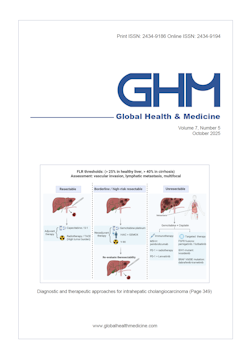Global Health & Medicine 2024;6(3):174-182.
Prevalence and associated factors of low vigor in patients living with HIV and hemophilia in Japan: A cross-sectional observational study
Komatsu K, Kimura S, Kiryu Y, Watanabe A, Kinai E, Oka S, Kimura S, Fujitani J, Ogata M, Minamimoto R, Hotta M, Yokoyama K, Noguchi T, Imai K
People living with human immunodeficiency virus (HIV) are at high risk of mental health problems. However, little is known about this risk in HIV-infected patients with hemophilia (HPH) who contracted the virus through blood products. This cross-sectional, observational study assessed patients' mood states and the factors associated with them among Japanese HPH to evaluate the need for psychosocial support. HPH completed self-administered questionnaires (Profile of Mood States [POMS] and General Health Questionnaire-28), neuropsychological tests, and brain magnetic resonance imaging (MRI) and fluorodeoxyglucose positron emission tomography/computerized tomography scans. HIV-infected patients with no hemophilia (HPnH) completed POMS and neuropsychological tests. Socio-demographic characteristics and HIV- and hemophilia-related data were obtained from participants' medical records and interviews. A Mann–Whitney U test and chi-squared analyses were conducted. Fifty-six HPH and 388 HPnH completed the questionnaires and neuropsychological tests. HPH had a significantly lower prevalence of tension–anxiety (HPH, 7%; HPnH, 18%; p = 0.049) and a significantly higher prevalence of low vigor (HPH, 63%; HPnH, 32%; p < 0.001). Low vigor in HPH was significantly associated with impaired executive function (low vigor, 66%; high vigor, 33%; p = 0.019) and a social dysfunction score ≥ 3 (moderate; low vigor, 26%; high vigor, 5%; p = 0.047). Our results highlight the high prevalence of low vigor among HPH, leading to impairments in executive and social functions. Therefore, healthcare workers need to pay attention to the vigor, executive function, and social function of HPH.
DOI: 10.35772/ghm.2023.01108







